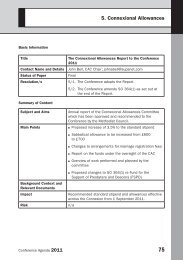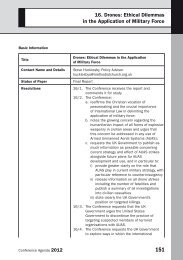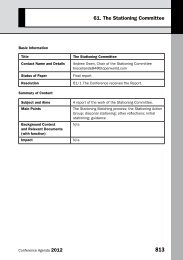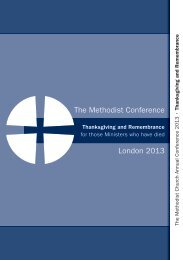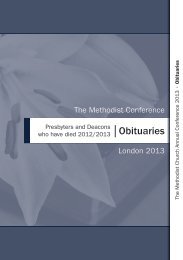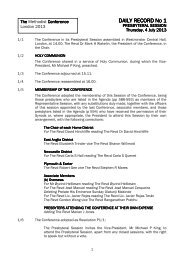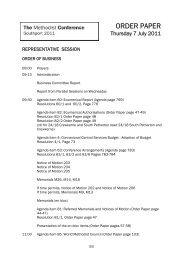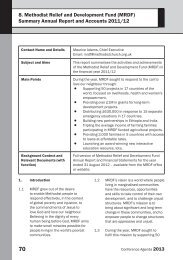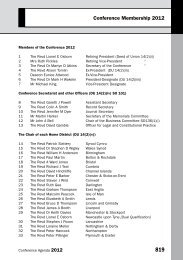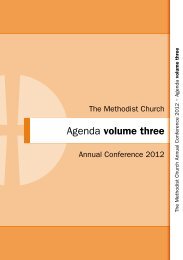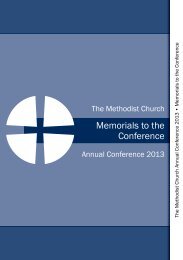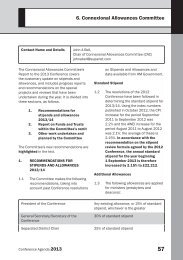Agenda Volume 2 - Methodist Conference
Agenda Volume 2 - Methodist Conference
Agenda Volume 2 - Methodist Conference
Create successful ePaper yourself
Turn your PDF publications into a flip-book with our unique Google optimized e-Paper software.
35. Larger than Circuit<br />
be done on a ‘larger than circuit’<br />
basis than a generation ago, and this<br />
trend is likely to increase. Not all of it<br />
is new, and some represents a move<br />
from staff being based centrally<br />
(which may itself raise the question<br />
whether there comes a point when<br />
a move back in the other direction<br />
might be the most efficient way<br />
of handling certain matters). But<br />
the main point is that the ultimate<br />
effect upon a local church or circuit’s<br />
finances needs to be acknowledged.<br />
(It is a separate question, not for<br />
this report, whether there are in fact<br />
ample capital resources held by local<br />
churches and circuits to fund all<br />
that we would aspire to do, and<br />
more!)<br />
69. But to return to the question of<br />
district sustainability: it is also –<br />
indeed perhaps primarily - about the<br />
sorts of work that district life entails<br />
and which would traditionally have<br />
always had a willing volunteer who<br />
would feel called, even privileged,<br />
to do eg representing the district<br />
on a connexional body, being<br />
treasurer of a fund, organising the<br />
tea at Synod... If there are in many<br />
parts of the connexion difficulties<br />
in filling what many would see as<br />
essential roles in local church and<br />
circuit life, it is hardly surprising that<br />
there are problems in doing so in<br />
district appointments. That is not,<br />
of course, to say that ‘districts are<br />
not sustainable’ as such. But it does<br />
still mean that the questions of what<br />
work can and should be sustained,<br />
and what is the best pattern or<br />
patterns for doing so, are ones which<br />
are rightly asked now.<br />
SECTION 4 ‘LARGER THAN CIRCUIT’:<br />
WHY ANYTHING?<br />
70. In setting up the working party, the<br />
<strong>Methodist</strong> Council saw the task as<br />
linking the process of the Regrouping<br />
for Mission initiative into ‘larger than<br />
circuit’ entities. The phrase ‘larger<br />
than circuit’ has therefore been<br />
used throughout this report: it is a<br />
useful reminder that the working<br />
party is not working to any preconceived<br />
model for the future (for<br />
instance, ‘larger than circuit’ does<br />
not necessarily mean ‘larger than<br />
[current] district’). The phrase is<br />
simply referring to those ‘in between’<br />
aspects of the church’s life, currently<br />
focused in entities and activities<br />
which have a broader than circuit,<br />
but not connexion-wide, basis.<br />
71. The first question is then: does<br />
the church now need any such ‘in<br />
between’ layer? Would it not be<br />
simpler – and cheaper – to work<br />
on the basis of a direct relationship<br />
of the circuits with the connexional<br />
governance bodies and Connexional<br />
Team?<br />
72. This is a question which was<br />
considered at some length by the<br />
North West Districts and Isle of<br />
Man in their extensive review, and<br />
the working party has found their<br />
analysis very helpful, emerging as<br />
it did from a process involving a<br />
number of districts working from<br />
384<br />
<strong>Conference</strong> <strong>Agenda</strong> 2013



